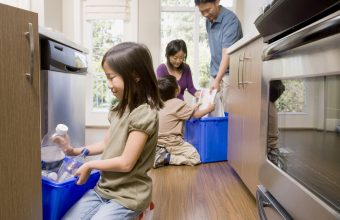With Earth Day quickly approaching, going green is top of mind for many’my family included. But instead of trying to live green for one day or one month, what if you and your family made a long-term commitment to reducing your environmental footprint?
I’ve recently discovered millions of homes across the country share a dirty little secret—Canadian households typically have three zones that can consume up to 60% of energy usage. However, by making small, mindful changes, families can turn their impact from negative to positive.
In my books, Green For Life and There’s Lead in Your Lipstick, I talk about the small and easy changes families can incorporate into their day-to-day lives to eliminate harmful chemicals, save on energy costs and leave you feeling good about your environmental footprint. By focusing on each area as a ‘greenable zone’, it is possible to unlock countless environmental saving opportunities.
The first step is to identify which areas of your life have the most potential for green living’if your family is anything like mine, you undoubtedly spend the most time in the kitchen and there are several simple changes that can be made:
- What are you cleaning your countertops with? Our food is in direct contact with whatever chemical ingredients we use to clean kitchen surfaces, so make sure to avoid hazardous toxins in your kitchen cleaning products.
- Keep a pitcher of cold water filled from the tap in your fridge. Why? The water helps maintain the cool temperature inside and allows your refrigerator to work more effectively at a lower temperature.
- Did you know a simple sheet of paper can help detect heat loss from your stove? Use Gill’s simple paper trick to discover if your stove is leaking the heat you’ve spent good money on for baking and cooking.
- Ever wonder why your dishwasher has a delay button? Many newer model washers allow you to set a later time for dishwashing so your energy consumption occurs during off-peak hours when electricity rates are lower and energy consumption is less taxing to the grid.
Where does an estimated 65% of your home’s total indoor water use take place? The bathroom. In this room, small simple changes can make a big impact:
- Start a family shower challenge and save on water and energy use by reducing the amount of time everyone spends under the hot water. Set a timer in the shower; the goal is five minutes, but you can work your way down in increments. See which family member can take the shortest showers.
- Install a low-flow showerhead to make your shower pressure feel stronger while actually using less water. Available at any hardware store, the low-flow showerhead is a no-brainer.
- Be aware of the product you use to clean your sink and tub. Non-biodegradable chemicals impact our water supply and also come in contact with small children taking baths.
As Canadians, there are many alternatives that we can start to integrate into our daily lives that will help make the planet a cleaner, healthier and more enjoyable place to live. The laundry room is the final room in the house where small changes can make a big difference:
- Overhaul your laundry shelf by purchasing products that only offer biodegradable detergents, and packaging made from post consumer waste. Seventh Generation for example makes a biodegradable and non-toxic detergent that even comes in a fully compostable package.
- What is the cheapest and easiest way to avoid static cling before it happens? Scrunch up a ball of tinfoil and toss it in the dryer to eliminate static electricity.
- To prolong the lifespan of your washing machine, clean it once a year by running a full (light) cycle with 2 cups of white vinegar.
There are lots of great online resources that offer tips and tricks on how to live a greener life’education is the key. I follow several green companies online for daily tips and green giveaways; my personal favourite is Seventh Generation.
Tagged under: cleaning,Earth day,green living
Category: green-living






